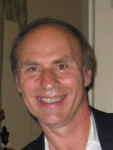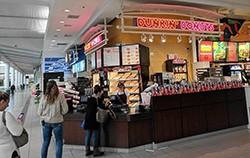A. Lender’s Bagels, in New Haven, Connecticut, gained success by purchasing the first automated bagel making machine from its inventor, Daniel Thompson. The machine rolled out the dough which then fed through a punching machine that punched out the inner hole and the bagel itself, eliminating the huge expense of hand rolling bagels. A Lender’s employee, Harry Leibowitz, recognized the possibility of using that machine to make doughnuts, and Murray Lender allowed him to experiment in the afternoons when the days’ bagel making was done. Finding success, Leibowitz eventually purchased his own machine and began making doughnuts which he sold initially from a retail store in New Haven, eventually adding a second location in Riverdale, New York. He named the store Dunkin’ Doughnuts, eventually adding more locations and then franchising the business, while changing the name to Dunkin’ Donuts. The chain was acquired in 1990 by the holding company Allied Lyons, which also includes Baskin & Robbins and Maker’s Mark among its brands.
B. Dunkin’ Donuts was founded by Isaiah Vaisman, a Jewish immigrant from Galicia to Toronto, Canada in the early 1930’s. Vaisman started as a peddler in the heavily Jewish Kensington Market neighborhood of Toronto, where he regularly purchased coffee to drink at the local Tim Hortons restaurant. Like many Jewish immigrants, Vaisman had higher aspirations, and he decided that there could be a future in the food industry. He took a job at Tim Hortons, first at the counter, and later moving up to a managerial position, before leaving the company in 1944 to open his own coffee and doughnut shop, which he called White’s Doughnuts. The store was successful, especially when he began selling not only doughnuts, but also fried doughnut holes, which he called Munchkins. The store expanded, and Vaisman later changed the name to Dunkin’ Donuts after watching so many customers happily dipping their doughnuts into their coffee.
C. In 1935, Charles Lubin and his brother-in-law, Arthur Gordon, both sons of European Jewish immigrants, bought a small chain of bakeries in Chicago which were called Community Bake Shops. It was around this time that the classic New York cheesecake became popular, as Lindy’s and Reuben’s feuded over who actually developed this recipe. Charles Lubin visited New York in the late 1930’s and decided to add a cheesecake to their bakery’s lineup. Arthur Gordon did not agree that this was a good idea, arguing that the bakery should focus on expanding its line of doughnuts. The two split up, with Lubin maintaining ownership of Community Bake Shops, to which he added a cheesecake named after his daughter Sara Lee. The cheesecake was hugely successful, and the company eventually changed its name to Sara Lee Corporation, selling frozen cheesecakes throughout the country. Gordon, however, was also successful, as he opened his own doughnut shop which he named Dunkin’ Doughnuts near Chicago’s Wrigley Field, the first of what became a multinational doughnut chain, later renamed Dunkin’ Donuts.
D. Dunkin’ Donuts was started by a Jewish entrepreneur, William Rosenberg of Boston. During the Depression, Rosenberg dropped out of school after 8th grade and began working for the Jack and Jill Ice Cream Company, eventually becoming national sales manager. He later worked as an electrician at a Boston shipyard during World War II, where he noticed the lunch carts which sold coffee, sandwiches, and snacks to the employees. He decided to buy his own trucks and launch a mobile food stand business, redesigning the trucks with a side wall that opened awning-style for selling the food. Following great success Rosenberg opened his first retail store, and focused on the coffee and doughnuts that were so successful from the trucks. He named the establishment Open Kettle, and as this business expanded, he later changed the name to Dunkin’ Donuts.
E. The Wizard of Oz was filmed at MGM Studios in the late 1930’s. Mendel Mayer, a Jewish immigrant from Poland, lived in New York at the time, where he struggled to make a living selling doughnuts from a cart on the Lower East Side. His cousin, Louis B. Mayer, the head of MGM Studios, invited Mendel to Los Angeles to make doughnuts for the cast to enjoy during the long days of filming. Mendel moved to L.A. and set up his cart at the studio, where his primary product was a small round doughnut which he called Munchkins. The actors, crew, and executives all loved the doughnuts, but they were especially prized by the elf-like actors who greeted Dorothy when her house landed in Oz. These actors, who had to that point been called Ozlings, decided that they preferred to be called Munchkins, and movie director Victor Fleming agreed to that change. Following the release of the movie, Mendel Mayer opened his first doughnut restaurant, Munchkinland, but he later changed the name to Dunkin’ Donuts.
*

